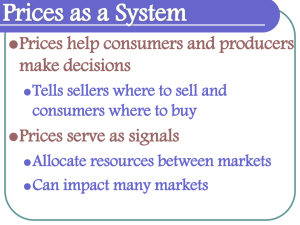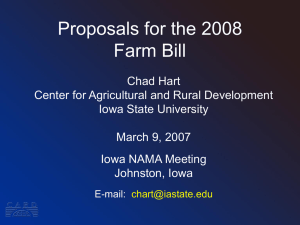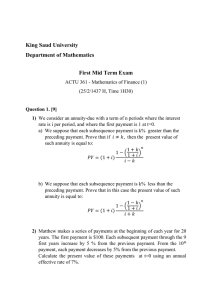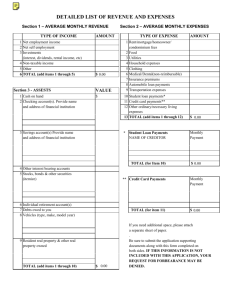Proposals for the 2008 Farm Bill
advertisement
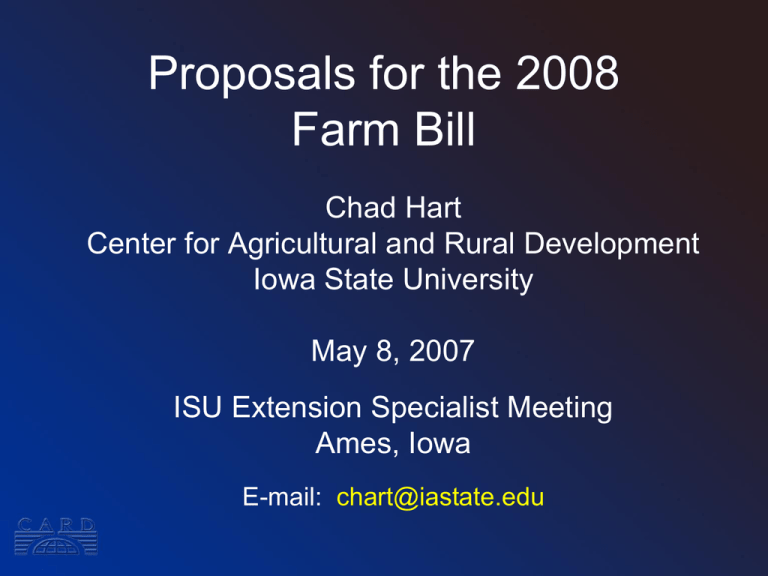
Proposals for the 2008 Farm Bill Chad Hart Center for Agricultural and Rural Development Iowa State University May 8, 2007 ISU Extension Specialist Meeting Ames, Iowa E-mail: chart@iastate.edu Current Farm Support • Three main programs – Direct Payment Program – Counter-cyclical Payment Program – Marketing Loan Program • Direct payments are fixed; counter-cyclical and marketing loan payments vary with price Key Settings Crop Target Price ($/bu.) 2.63 Direct Payment Rate ($/bu.) 0.28 National Loan Rate ($/bu.) 1.95 Soybeans 5.80 0.44 5.00 Wheat 3.92 0.52 2.75 Corn When Payments Are Triggered $200.00 Returns ($/acre) $150.00 $100.00 $50.00 $0.00 -$50.00 -$100.00 $1.50 $1.70 $1.90 $2.10 $2.30 $2.50 $2.70 $2.90 $3.10 $3.30 $3.50 Price ($/bushel) Market Return less Variable Costs Countercyclical Payment Net Crop Insurance Benefit Direct Payment Marketing Loan Benefit Farm Bill Budget • Budget determined by Congress, but based on projections of spending for current farm bill • With crop prices projected to remain high, current farm support program cost are projected to be low • This doesn’t leave much room for farm bill changes Farm Bill Proposals • There are many proposals out there – – – – – – USDA National Corn Growers Association American Soybean Association National Association of Wheat Growers American Farmland Trust American Farm Bureau • Can be divided into two camps – Modify current structure – Move to revenue-based farm support Wheat Proposal • Higher target price – Wheat: $5.29/bu., up $1.37 • Higher direct payment rate – Wheat: $1.19/bu., up $0.67 • No change on loan rate • No specifics on other crops Wheat Proposal • Proposal would more than double direct payments • Counter-cyclical payments would trigger at prices below $4.10/bu. – Currently triggered at $3.40/bu. • Counter-cyclical payment rate would max at $1.35/bu. – Current max of $0.65/bu. Soybean Proposal • Higher target prices – Higher of current target price or 130% of 2000-2004 Olympic average of season-average prices • Higher loan rates – Higher of current loan rate or 95% of 2000-2004 Olympic average of season-average prices • No change on direct payments Soybean Proposal Crop Target Price ($/bu.) 2.75 Direct Payment Rate ($/bu.) 0.28 National Loan Rate ($/bu.) 2.01 Soybeans 6.85 0.44 5.01 Wheat 4.15 0.52 3.03 Corn Payments under Soybean Proposal $200.00 Returns ($/acre) $150.00 $100.00 $50.00 $0.00 -$50.00 -$100.00 $1.50 $1.70 $1.90 $2.10 $2.30 $2.50 $2.70 $2.90 $3.10 $3.30 $3.50 Price ($/bushel) Market Return less Variable Costs Countercyclical Payment Net Crop Insurance Benefit Direct Payment Marketing Loan Benefit Payment Changes $200.00 Returns ($/acre) $150.00 $100.00 $50.00 $0.00 -$50.00 -$100.00 $1.50 $1.70 $1.90 $2.10 $2.30 $2.50 $2.70 $2.90 $3.10 $3.30 $3.50 Price ($/bushel) Market Return less Variable Costs Countercyclical Payment Net Crop Insurance Benefit Direct Payment Marketing Loan Benefit Iowa Soybean Association • Proposed reducing direct payments to pay for target price and loan rate changes • Also suggested the balance of direct payments could be directed to risk management vouchers Why Switch to Revenue? • Critics of the current farm bill point to two main factors – Continuing need for disaster assistance – Possible overcompensation from price-based programs • Example: 2004 for corn, record corn yields, 3rd highest corn crop value, large corn government payments • Targeting revenue, instead of price, can address these factors Corn Proposal • Revenue-based support program – County-level (Revenue Counter-Cyclical Program) • Marketing loans changed to recourse loans (means farmers could not forfeit crop as payment for loan) • No change on direct payments Revenue Counter-Cyclical Program • Somewhat like current counter-cyclical program • Revenue guarantee = 95%*County trend yield*Projected price • Projected price based on 3-year average with cups and caps • Actual county revenue = County yield*National price • Payments made when actual county revenue is below revenue guarantee • Integrated with crop insurance – Premiums and indemnities reduced by payments from revenue counter-cyclical program American Farmland Trust Proposal • Similar to National Corn Growers’ Proposal – Revenue-based counter-cyclical program • Revenue guarantee = Percentage*National trend yield*Projected price • Actual revenue = National yield*National price • Payments made when actual revenue is below revenue guarantee • Integration with crop insurance – Premiums and indemnities reduced by payments from revenue counter-cyclical program American Farm Bureau Proposal • Maintain target prices, direct payments, and loan rates from current farm bill • Move to state-based revenue counter-cyclical program • Revenue guarantee = (Target price – Direct payment rate)*2002-06 Olympic average state yield • Actual revenue = State yield*Max(Season-average price, National loan rate) • Payments made when actual revenue is below revenue guarantee American Farm Bureau Proposal • Paid on current CCP base acreage, not base production • County-based standing disaster program – 50% of 5-year Olympic average yield*5-year Olympic average price • CAT and NAP eliminated • Paid for via crop insurance savings and producer fees – $0.80 per $100 of crop receipts • Crop insurance savings generated because insurance payments are capped at a 50% loss USDA Proposal • Set loan rate at minimum of loan rates in Housepassed version of 2002 farm bill or 85% of 5year Olympic average prices • Change marketing loan program from daily price settings to monthly price settings • Increase direct payment rates • Change counter-cyclical program to be revenuebased USDA Proposal Crop Target Price ($/bu.) 2.63 Direct Payment Rate ($/bu.) 0.30 Max. Nat. Loan Rate ($/bu.) 1.89 Soybeans 5.80 0.50 4.92 Wheat 3.92 0.56 2.58 Corn USDA’s Revenue Counter-Cyclical Program • Revenue guarantee = 2002-2006 National Olympic average yield*Effective target price – Effective target price = Target price – Direct payment rate • Actual revenue = National yield*Max(Season-average price, National loan rate) • Payments made when actual revenue is below revenue guarantee • Pays on base acres and yields, not planted acres and actual yields Corn Example • 2002-2006 National Olympic average yield = 146.4 bu./acre • Effective target price = $2.35/bu. • Target revenue = $344.04/acre • National yield = 130 bu./acre • Season-average price = $2.30/bu. • Actual revenue = $299.00/acre • Farm program yield = 114.3 bu./acre • Current program payment = $0.05/bu. – ($2.35 - $2.30) • Proposed program payment = $0.394/bu. – (($344.04 - $299.00)/114.3) Congressional Ideas on Disaster Assistance • Several packages have been proposed to establish permanent disaster assistance • One package is built like past disaster packages – 35% loss threshold – Paid at 65% of insurance price – Must have purchased crop insurance or agree to purchase crop insurance during the next two years Congressional Ideas on Disaster Assistance • Other option limits disaster assistance completely to those buying crop insurance and helps cover “shallow losses” – Expected yield = Max (APH yield, CCP yield, 5-yr Olympic county average yield) – Expected price = Crop insurance price – Farm guarantee = Expected yield*Expected price*Crop insurance coverage level*120% – Actual revenue = Actual yield*Price (from 1st 5 months of marketing year) – Combined payments from crop insurance and disaster assistance limited to 90% of expected revenue – Disaster assistance payments reduced by crop insurance payments (reverse of NCGA and AFT plans) The Next Farm Bill? • May look like some of these proposals – As time proceeds, the odds increase for packages that look like the wheat and soybean proposals • Congress usually blazes its own trail – USDA proposals do not carry significant weight in Congress • Cost will be a major consideration
